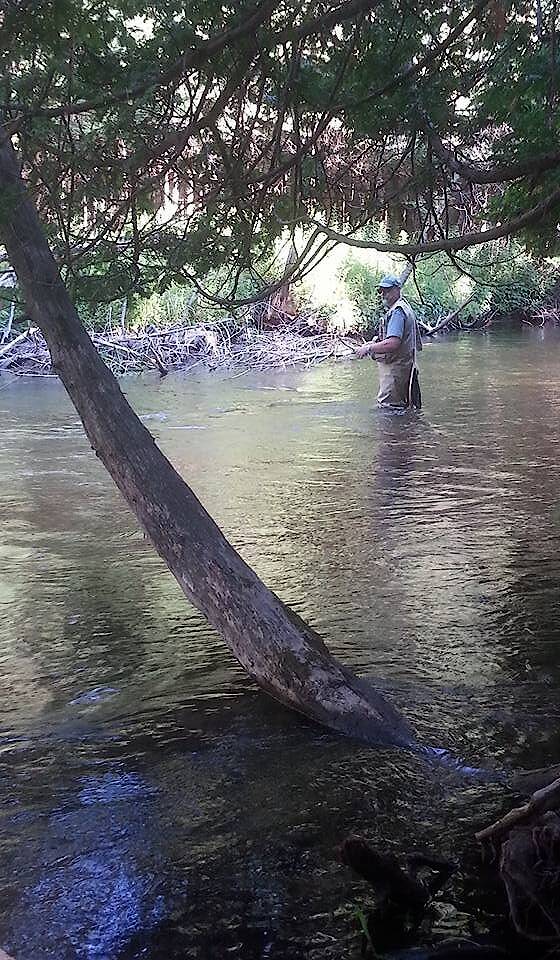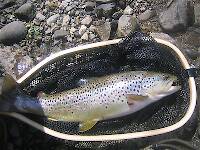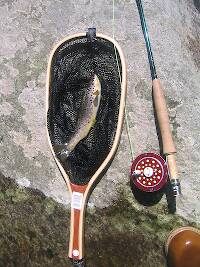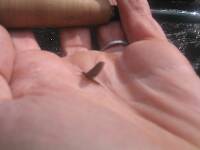
Hex Mayflies
Hexagenia limbata
The famous nocturnal Hex hatch of the Midwest (and a few other lucky locations) stirs to the surface mythically large brown trout that only touch streamers for the rest of the year.
Featured on the forum

This specimen keys pretty easily to Onocosmoecus, and it closely resembles a specimen from Alaska which caddis expert Dave Ruiter recognized as this genus. As with that specimen, the only species in the genus documented in this area is Onocosmoecus unicolor, but Dave suggested for that specimen that there might be multiple not-yet-distinguished species under the unicolor umbrella and it would be best to stick with the genus-level ID. I'm doing the same for this one.

Troutnut is a project started in 2003 by salmonid ecologist Jason "Troutnut" Neuswanger to help anglers and
fly tyers unabashedly embrace the entomological side of the sport. Learn more about Troutnut or
support the project for an enhanced experience here.
Roguerat on Jun 30, 2012June 30th, 2012, 2:11 pm EDT
I've noticed some variation in eye color during recent Sulfur and BWO hatches lately. The Sulfurs were the most noticeable in that now and then I'd see a dun with near-orange eyes. The BWO's were more subtle, a brownish-red and a very subdued shade at that.
I've seen Sulfur patterns with red-orange thread-heads,but so far haven't seen any BWO patterns noting use of red-brown (mahogany?)for tying off the head of the fly.
Any experience or wisdom on this one, or whether or not exact head-color attracts more trout or increases hook-up rates?
A note on weather here in SW Michigan, we're really dry...the Rogue is at near-record low-flow for this time of year and in 2 hours this past Monday night we didn't see one fish rise.
The Roguerat
I Peter 5:7 'Cast your cares upon Him...'
I've seen Sulfur patterns with red-orange thread-heads,but so far haven't seen any BWO patterns noting use of red-brown (mahogany?)for tying off the head of the fly.
Any experience or wisdom on this one, or whether or not exact head-color attracts more trout or increases hook-up rates?
A note on weather here in SW Michigan, we're really dry...the Rogue is at near-record low-flow for this time of year and in 2 hours this past Monday night we didn't see one fish rise.
The Roguerat
I Peter 5:7 'Cast your cares upon Him...'
Sayfu
Posts: 560
Posts: 560
Sayfu on Aug 13, 2012August 13th, 2012, 12:12 pm EDT
If one thinks shiny eyes could trigger a take, or make a fly appear more authenic, I always first place a tiny plastic bead about he size of a bug head on the hook before dressing it..makes it easy to tie because you can't crowd the eye now...no cement gets in the eye, and easy to tie off material pulling thread, material down behind the eye..should be outlawed it makes tying so easy. :)
Wbranch on Aug 13, 2012August 13th, 2012, 6:44 pm EDT
Where I fish many of the Sulfurs have big rust colored eyes. I don't know if the fish give a hoot but I use 8/0 Uni rust when tying those duns and actually build up the thread a bit to make it wider than most of my flies. I don't know if the large eyes define a male from a female or vice versa but I'm sure Taxon will be able to tell us.
Catskill fly fisher for fifty-five years.
Wbranch on Aug 13, 2012August 13th, 2012, 6:47 pm EDT
"I always first place a tiny plastic bead about he size of a bug head on the hook before dressing it..makes it easy to tie because you can't crowd the eye now...no cement gets in the eye, and easy to tie off material pulling thread, material down behind the eye"
Have you researched this technique to be able to determine if it is more successful than flies tied without the "tiny plastic bead"? Do you use colored beads to replicate the eye of the insect or just pick one color and stick with it?
Have you researched this technique to be able to determine if it is more successful than flies tied without the "tiny plastic bead"? Do you use colored beads to replicate the eye of the insect or just pick one color and stick with it?
Catskill fly fisher for fifty-five years.
Sayfu
Posts: 560
Posts: 560
Sayfu on Aug 14, 2012August 14th, 2012, 7:07 am EDT
No, my thinking is very amateurish, and for small flies...when I put the hook in the vice after bending down the barb,and then sliding up the bead, my blood pressure seems to go down. :) For one, being on the river, pulling a small pattern out of my box that I desperately need, and then having to scour the ground to find it only to find I can't thread on the tippet anyway because the eye is partially closed with thread, has been very frustrating. The tiny bead helps me to center the tippet as well as keep lacquer out of the eye. My proportions are always right. For some reason I do not like a long thread head. And I can see one of Poly's ties from a distance when the book is opened up! Thread never shows using a bead. Materials are tied off positively when secured behind the bead. and I finish off with the Borger Knot for no other name to call it...I do not whip finish. My thinking on color is to most often use a black head, but those XSM beads come in green, brown, have no wt. and will often slide onto a #12 dryfly hook. I use no scientific info for using what color, and if dubbing is used right up to the bead, even part of that small bead doesn't show. I've seen tiers use an epoxy to create a shiny bug head for their thread heads. Using a bead accomplishes this pronto gusto. I can tie size #20 soft hackles using the bead, and then taking a starling feather let's say, and cutting out the tip section of the feather, and securing it behind, or on the bumped up thorax, and behind the bead, several loose thread wraps..tighten, and soft hackle legs pop out to the side for the most part where I want them, and easily secured behind the bead. I had an incredible late afternoon fishing one day this year on the Henry's fork matching Glossosoma, little black horned sedge, after going fishless all day long, and ready to give it up. They were everywhere, and along fast water. I had no #18 black caddis dries, and wouldn't have tried to use one anyway not being able to see it. A drag free float would have been next to impossible. But in my soft hackle box, I had some #18 black soft hackles with the starling feather "applied" behind a black bead, and black dubbing on a short shanked caddis/pupa hook that I swung in the current..no sight, just the big tug. Can't ever remember my day being turned around like that one!! And I got by using a 3x tippet on those small SH's!
Entoman on Aug 14, 2012August 14th, 2012, 8:00 am EDT
Matt - Yes, it's the males that have the big bright eyes. Using thread to match them does impact the overall color of the fly, so if you find it important to imitate this feature, the best way is to use a neutral thread to tie the fly and "paint" 3 inches or so of it with the proper colored marker for finishing off the head. Coat it well with lacquer or the color will bleach out in use. They can be many different shades of yellow, red, orange and even green. The most obvious ones from a fishing standpoint are on the March Browns, Cahills, several species of baetid, and the pale ephemerellids. Their proportions and striking color can really stand out. Having said all this, I have to admit that coloring the head to match eyes has never proved to be all that significant in my years of fooling around with fly patterns.
Jere - using beads on drys is an interesting concept and your reasoning makes a lot of sense, especially for imitating the out-sized bright eyes of male mayflies. The only thing that stops me from experimenting with them (besides an admittedly stodgy sense of aesthetic) is they preclude the use of my favorite knot for small dries, the improved turle.
Jere - using beads on drys is an interesting concept and your reasoning makes a lot of sense, especially for imitating the out-sized bright eyes of male mayflies. The only thing that stops me from experimenting with them (besides an admittedly stodgy sense of aesthetic) is they preclude the use of my favorite knot for small dries, the improved turle.
"It's not that I find fishing so important, it's just that I find all other endeavors of Man equally unimportant... And not nearly as much fun!" Robert Traver, Anatomy of a Fisherman
Sayfu
Posts: 560
Posts: 560
Sayfu on Aug 14, 2012August 14th, 2012, 8:42 am EDT
Entomen..Are you familiar with the knot I call the Borger knot? I watched Borger tie it many years ago now, and never looked back..I won't describe it totally, but you just extend the thread on the bobbin, left finger on top of the thread, and over the top of the eye once, twice with the thread, and now you've formed a loop that you can move forward of the eye, bobbin goes aft direction, and pull it up getting your left index finger out of the way. (eye goes in the center of the loop when you move the loop down, and forward.) You avoid catching hackles, I can catch a trimmed off hackle as I pull it up toward the back, and I can put head cement on the thread above my finger, pull it up, get my finger out of the way, and now place head cement in the knot. The bead even prevents the knot from coming undone as it is formed below the top of the bead.
Sayfu
Posts: 560
Posts: 560
Sayfu on Aug 14, 2012August 14th, 2012, 8:43 am EDT
Darn! You are bad enough singularly! :) Now I have to pluralize you! ENTOMAN!
Entoman on Aug 14, 2012August 14th, 2012, 2:23 pm EDT
Yeah, I guess one of me is more than enough. :)
No, I'm not familiar with the Borger knot. Though probably a very fine one, the ones I currently use have been refined over more than 40 years in my clumsy hands. All that practice makes them pretty hard to beat for me, whether it's knocking out a six dozen flies in a day or tying on a size 18 fly in near dark conditions. I'd hate to do either while trying to learn a new knot.:)
No, I'm not familiar with the Borger knot. Though probably a very fine one, the ones I currently use have been refined over more than 40 years in my clumsy hands. All that practice makes them pretty hard to beat for me, whether it's knocking out a six dozen flies in a day or tying on a size 18 fly in near dark conditions. I'd hate to do either while trying to learn a new knot.:)
"It's not that I find fishing so important, it's just that I find all other endeavors of Man equally unimportant... And not nearly as much fun!" Robert Traver, Anatomy of a Fisherman
Gutcutter on Aug 18, 2012August 18th, 2012, 7:52 am EDT
if you find it important to imitate this feature, the best way is to use a neutral thread to tie the fly and "paint" 3 inches or so of it with the proper colored marker for finishing off the head
I tie "eyes" a little less complicated than this.
As I start to form the head with my regular "fly" thread, I tie in the "eye" color thread with three wraps of the "fly" thread and then a three turn whip finish with the "fly" thread and cut the "fly" thread.
Then I tie in the new head over that with the "eye" thread and make the desired size eyes, followed by a five turn whip finish. Takes about fifteen seconds.
I have to admit that coloring the head to match eyes has never proved to be all that significant in my years of fooling around with fly patterns.
I do it for fun, and confidence. There have been many occasions where an orange head PMD out fishes a regular one, or I slayed them on red head Sulfur when nothing else worked, but I think in those instances it was more likely me, than my fly
All men who fish may in turn be divided into two parts: those who fish for trout and those who don't. Trout fishermen are a race apart: they are a dedicated crew- indolent, improvident, and quietly mad.
-Robert Traver, Trout Madness
-Robert Traver, Trout Madness
Entoman on Aug 18, 2012August 18th, 2012, 9:53 am EDT
Tony -
I think you may have misunderstood me. I meant using the same thread for the whole fly. After you tie down the hackle (assuming that's the last step), simply uncap a fluorescent marker and paint 3" or so of the thread before applying the finishing wraps and the whip. Takes, I dunno, an additional 3-4 seconds? I don't see how this is more complicated.
Good point. I've noticed that a bit of bright orange in a PMD pattern often works better as well. Never associated the reason before (other than assuming an exaggerated body tint), but it makes sense that it could be the eyes.
As for Sayfu's method, I've seen some opaque bright orange plastic beads that would match the eyes more or less perfectly - in bulk, shape and color (lighter than a bulky and lacquered thread head too). Cool idea! Now if I could just let go of the imp. turle...:)
"if you find it important to imitate this feature, the best way is to use a neutral thread to tie the fly and "paint" 3 inches or so of it with the proper colored marker for finishing off the head"
I tie "eyes" a little less complicated than this.
As I start to form the head with my regular "fly" thread, I tie in the "eye" color thread with three wraps of the "fly" thread and then a three turn whip finish with the "fly" thread and cut the "fly" thread.
Then I tie in the new head over that with the "eye" thread and make the desired size eyes, followed by a five turn whip finish. Takes about fifteen seconds.
I think you may have misunderstood me. I meant using the same thread for the whole fly. After you tie down the hackle (assuming that's the last step), simply uncap a fluorescent marker and paint 3" or so of the thread before applying the finishing wraps and the whip. Takes, I dunno, an additional 3-4 seconds? I don't see how this is more complicated.
There have been many occasions where an orange head PMD out fishes a regular one, or I slayed them on red head Sulfur when nothing else worked...
Good point. I've noticed that a bit of bright orange in a PMD pattern often works better as well. Never associated the reason before (other than assuming an exaggerated body tint), but it makes sense that it could be the eyes.
As for Sayfu's method, I've seen some opaque bright orange plastic beads that would match the eyes more or less perfectly - in bulk, shape and color (lighter than a bulky and lacquered thread head too). Cool idea! Now if I could just let go of the imp. turle...:)
"It's not that I find fishing so important, it's just that I find all other endeavors of Man equally unimportant... And not nearly as much fun!" Robert Traver, Anatomy of a Fisherman
Sayfu
Posts: 560
Posts: 560
Sayfu on Aug 18, 2012August 18th, 2012, 11:07 am EDT
A XSM plastic bead head I often use is a peacock colored bead. And I will be trying them out on WED. Just got a good report of Epeorus Albertae,(cahills) coming off in the faster, riffle water in our canyon. We've got too much water coming down out of our dam still to wade fish a number of our riffles, BUT, I can run up in my small jetboat, and anchor up, and cover this water with my pink albert emerging soft hackle with the synthetic fiber wing I developed last year that worked so well. The young angler that gave me the report said all the guides were off the water when they fished it in the evening, and did well.
Quick Reply
Related Discussions
Topic
Replies
Last Reply
2
Oct 18, 2010
by Jmd123
by Jmd123
0
Jan 27, 2017
by Mcflyangler
by Mcflyangler








